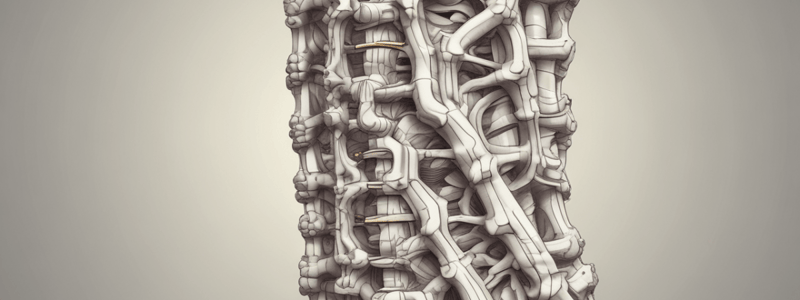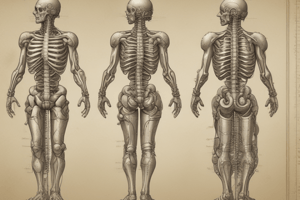Podcast
Questions and Answers
What is the primary function of the disks and S-shaped structure of the vertebral column?
What is the primary function of the disks and S-shaped structure of the vertebral column?
- To protect the spinal cord from injury
- To facilitate bending and flexion
- To absorb shock and prevent damage to the head (correct)
- To support the body's weight
What happens when we walk or run without the disks and S-shaped structure of the vertebral column?
What happens when we walk or run without the disks and S-shaped structure of the vertebral column?
- The head moves more freely
- The spine becomes more rigid
- The shock is transmitted directly to the head (correct)
- The body's weight is more evenly distributed
What is the shape of the structure that works with the disks to prevent shock to the head?
What is the shape of the structure that works with the disks to prevent shock to the head?
- Circular
- S-shaped (correct)
- Triangular
- Linear
What is the purpose of the disks in the vertebral column?
What is the purpose of the disks in the vertebral column?
What activities benefit from the shock-absorbing function of the disks and S-shaped structure of the vertebral column?
What activities benefit from the shock-absorbing function of the disks and S-shaped structure of the vertebral column?
What types of spinal curvatures are present in the thoracic and sacral regions?
What types of spinal curvatures are present in the thoracic and sacral regions?
When do secondary spinal curvatures develop?
When do secondary spinal curvatures develop?
What is a characteristic of secondary spinal curvatures?
What is a characteristic of secondary spinal curvatures?
Which of the following is NOT a characteristic of spinal curvatures in the thoracic and sacral regions?
Which of the following is NOT a characteristic of spinal curvatures in the thoracic and sacral regions?
What can be said about the development of spinal curvatures in the thoracic and sacral regions?
What can be said about the development of spinal curvatures in the thoracic and sacral regions?
What is the primary function of the body or centrum of a vertebra?
What is the primary function of the body or centrum of a vertebra?
Through which structure does the spinal cord pass in a vertebra?
Through which structure does the spinal cord pass in a vertebra?
What is the function of the superior and inferior articular processes in a vertebra?
What is the function of the superior and inferior articular processes in a vertebra?
How many cervical vertebrae are there in the human spine?
How many cervical vertebrae are there in the human spine?
What is the name of the single projection that arises from the posterior aspect of a vertebra?
What is the name of the single projection that arises from the posterior aspect of a vertebra?
What is the name of the cervical vertebra that acts as a pivot point for the rotation of the atlas and the skull?
What is the name of the cervical vertebra that acts as a pivot point for the rotation of the atlas and the skull?
Which of the following is a function of the cervical vertebra mentioned in the passage?
Which of the following is a function of the cervical vertebra mentioned in the passage?
What is the name of the structure that the cervical vertebrae mentioned in the passage articulates with?
What is the name of the structure that the cervical vertebrae mentioned in the passage articulates with?
What is the name given to the cervical vertebra C2?
What is the name given to the cervical vertebra C2?
What movement does the cervical vertebra mentioned in the passage allow?
What movement does the cervical vertebra mentioned in the passage allow?
What is the name of the large process that sticks into the atlas?
What is the name of the large process that sticks into the atlas?
What is the distinctive feature of the transverse processes in cervical vertebrae?
What is the distinctive feature of the transverse processes in cervical vertebrae?
What is the shape of the bodies of thoracic vertebrae?
What is the shape of the bodies of thoracic vertebrae?
What is the characteristic feature of the spinous processes in thoracic vertebrae?
What is the characteristic feature of the spinous processes in thoracic vertebrae?
What is the shape of the bodies of lumbar vertebrae?
What is the shape of the bodies of lumbar vertebrae?
How many vertebrae fuse to form the sacrum?
How many vertebrae fuse to form the sacrum?
What is the human 'tailbone' formed by?
What is the human 'tailbone' formed by?
What is the function of the foramina in the transverse processes of cervical vertebrae?
What is the function of the foramina in the transverse processes of cervical vertebrae?
Study Notes
The Vertebral Column
- The vertebral column and disks work together to prevent shock to the head when walking or running.
- There are two types of curvatures: primary (present at birth) and secondary (develop after birth).
Vertebrae Structure
- The body or centrum is a disk-like, weight-bearing part of the vertebra that faces anteriorly in the vertebral column.
- The vertebral foramen is a canal through which the spinal cord passes.
- The spinous process is a single projection arising from the posterior aspect of the vertebra.
- Transverse processes are two lateral projections from the body.
- Superior and inferior articular processes are paired projections that allow a vertebra to form joints with adjacent vertebrae.
Cervical Vertebrae (C1-C7)
- The 7 cervical vertebrae form the neck region of the spine and articulate with the occipital condyles.
- They allow nodding and rotation of the head.
- C2 (axis) has a large process called the odontoid process, which sticks into the atlas.
- C3-C7 are typical vertebrae with short spinous processes and foramina in their transverse processes.
Thoracic Vertebrae (T1-T12)
- They are typical vertebrae with heart-shaped bodies and long spinous processes that point sharply downward.
- They can be identified by their giraffe-like head shape from the side.
Lumbar Vertebrae (L1-L5)
- They are the sturdiest vertebrae since most of the stress on the vertebral column occurs in the lumbar region.
- Their bodies are massive and block-like, and they can be identified by their moose-like head shape from the side.
Sacrum and Coccyx
- The sacrum forms the posterior wall of the pelvis and is formed by the fusion of 5 vertebrae.
- The sacral canal is the continuation of the vertebral canal inside the sacrum.
- The coccyx is formed by the fusion of 3 to 5 small, irregularly shaped vertebrae and is the human "tailbone".
Studying That Suits You
Use AI to generate personalized quizzes and flashcards to suit your learning preferences.
Related Documents
Description
Learn how the vertebral column and disks work together to prevent shock to the head when we move. Understand the importance of this structure in our daily activities.




